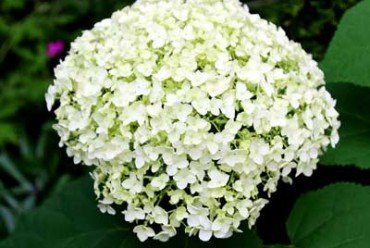
Question from Margaret S. in Kingston, Ont.
As a loyal follower from issue No. 1, I have come to look on you as my general garden encyclopaedia. However, I have a problem: This year my hitherto lovely hydrangea is quite luscious and green, but not a single flower.
I have been told that it’s lacking phosphate as my composted leaves have produced too much nitrogen and depleted the phosphate. It seems a fine balance. What to do? I dutifully shred all my many leaves — oak and maple — and then allow them to compost. The resulting tilth looks great and I thought I was doing the right thing in digging this into the garden, top dressing or mulching.
Beckie’s reply:
I can’t imagine shredded leaves and the resulting crumbly leaf mould would be a problem for your hydrangeas. Leaf mould is full of useful organic matter, and makes an excellent mulch.
Your hydrangeas may not be blooming because they have been pruned at an inappropriate time. Panicle hydrangeas (Hydrangea paniculata) require little, if any, pruning. If you do prune, do so before new growth begins — in late fall or in the very early spring — because flower buds are formed on new wood. If you are referring to smooth hydrangea (Hydrangea arborescens), these respond well to heavier pruning in late winter or very early spring (again, before new growth begins). I cut all stems of my smooth hydrangeas back to about 12 to 18 inches in February or March.
Another cause of reduced bloom may be too much shade. Although hydrangeas tolerate more shade than most flowering shrubs, they do require some sun to produce blooms. Also, hydrangeas like consistently moist soil—they are not drought tolerant.
I hope this information helps, and perhaps your hydrangeas will bounce back next year with lots of blooms. I’m glad to hear you enjoy the magazine. If you still have issue No. 21 (Great Plants to Grow), there is an article by Judith Adam on page 26 about growing panicle hydrangeas.
More articles about hydrangeas:
Do you have information to share?
If you have something to suggest, please do so in the comments section below. We know gardeners always have lots of information to share.
[post_comments]









Seven plants planted 2018. This the first year that all bloomed. Lots of blooms but none have bloomed all the way. In morning sun and partial shade in afternoon. They have been cut back in late November each year.
My Annabelle hydrangea has never bloomed in the 4 years that I have bought it. Just lots of leaves. In full sun all day
Very important with macrophylla hydrangea is to resist the urge to remove the leaves until well past the frost free date in your area. The buds contain both the leaves and flower buds will already be growing and if touched by frost the flower buds will not form and you will only have leaves
I have a similar problem to Margaret in Kingston. My three mature Hydrangea macrophylla shrubs have not flowered for the past two summers. In my case, the shrubs are in a west facing bed and due to the severe winters, the potential flower buds from the previous seasons growth were damaged. Since the macrophylla bloom on last years wood, I plan to heap shredded leaves over the plants this year, after the ground has frozen. Maybe they will reward me with those fabulous heads of colour next summer. Do you have any other suggestions?
Hello, Judy: Your plan to provide extra protection sounds reasonable, and certainly worth a try. Hydrangea macrophylla cultivars are slightly less hardy than cultivars of H. paniculata and H. arborescens, so it may be that you garden in an area where H. macrophylla is borderline hardy. In relatively mild winters, the flower buds may come through unscathed, but in a particularly harsh winter, they will be destroyed.